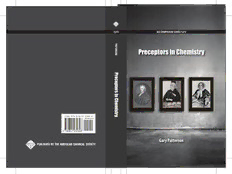
Preceptors in chemistry PDF
Preview Preceptors in chemistry
Preceptors in Chemistry 1273 ACS SYMPOSIUM SERIES Preceptors in Chemistry Gary Patterson, Editor Carnegie Mellon University Pittsburgh, Pennsylvania Sponsored by the ACSDivisionoftheHistoryofChemistry AmericanChemicalSociety,Washington,DC DistributedinprintbyOxfordUniversityPress LibraryofCongressCataloging-in-PublicationData LibraryofCongressCataloging-in-PublicationData Names:Patterson,GaryD.(GaryDavid),1946-editor.|AmericanChemical Society.DivisionoftheHistoryofChemistry. Title:Preceptorsinchemistry/GaryPatterson,editor(CarnegieMellon University,Pittsburgh,Pennsylvania);sponsoredbytheACSDivisionof theHistoryofChemistry. Description:Washington,DC:AmericanChemicalSociety,[2018]|Series:ACS symposiumseries;1273|Includesbibliographicalreferencesandindex. Identifiers:LCCN2018001119(print)|LCCN2018004383(ebook)|ISBN 9780841232792(ebook)|ISBN9780841232808(alk.paper) Subjects:LCSH:Chemists--Biography.|Chemistryteachers--Biography.| Chemistry--History. Classification:LCCQD21(ebook)|LCCQD21.P69452018(print)|DDC 540.92/2--dc23 LCrecordavailableathttps://lccn.loc.gov/2018001119 ThepaperusedinthispublicationmeetstheminimumrequirementsofAmericanNational Standard for Information Sciences—Permanence of Paper for Printed Library Materials, ANSIZ39.48n1984. Copyright©2018AmericanChemicalSociety DistributedinprintbyOxfordUniversityPress AllRightsReserved. ReprographiccopyingbeyondthatpermittedbySections107or108 oftheU.S.CopyrightActisallowedforinternaluseonly,providedthataper-chapterfeeof $40.25plus$0.75perpageispaidtotheCopyrightClearanceCenter,Inc.,222Rosewood Drive,Danvers,MA01923,USA.Republicationorreproductionforsaleofpagesinthis bookispermittedonlyunderlicensefromACS.Directtheseandotherpermissionrequests toACSCopyrightOffice,PublicationsDivision,115516thStreet,N.W.,Washington,DC 20036. Thecitationoftradenamesand/ornamesofmanufacturersinthispublicationisnottobe construedasanendorsementorasapprovalbyACSofthecommercialproductsorservices referenced herein; nor should the mere reference herein to any drawing, specification, chemicalprocess, orotherdataberegardedasalicenseorasaconveyanceofanyright or permission to the holder, reader, or any other person or corporation, to manufacture, reproduce,use,orsellanypatentedinventionorcopyrightedworkthatmayinanywaybe relatedthereto. Registerednames,trademarks,etc.,usedinthispublication,evenwithout specificindicationthereof,arenottobeconsideredunprotectedbylaw. PRINTEDINTHEUNITEDSTATESOFAMERICA Foreword The ACS Symposium Series was first published in 1974 to provide a mechanism for publishing symposia quickly in book form. The purpose of the series is to publish timely, comprehensive books developed from the ACS sponsoredsymposiabasedoncurrentscientificresearch. Occasionally,booksare developed from symposia sponsored by other organizations when the topic is of keeninteresttothechemistryaudience. Beforeagreeingtopublishabook,theproposedtableofcontentsisreviewed forappropriateandcomprehensivecoverageandforinteresttotheaudience. Some papersmaybeexcludedtobetterfocusthebook;othersmaybeaddedtoprovide comprehensiveness. When appropriate, overview or introductory chapters are added. Draftsofchaptersarepeer-reviewedpriortofinalacceptanceorrejection, andmanuscriptsarepreparedincamera-readyformat. As a rule, only original research papers and original review papers are included in the volumes. Verbatim reproductions of previous published papers arenotaccepted. ACSBooksDepartment Contents 1. Introductionto“PreceptorsinChemistry”........................................................... 1 GaryPatterson 2. HermanBoerhaaveandtheUseofDemonstration-Experimentsin ChemistryCourses................................................................................................. 29 JohnC.Powers 3. ANon-PublishingPreceptorPublished: TheThreeEditionsofJoseph Black’sElementsofChemistry............................................................................... 43 RobertG.W.Anderson 4. WilliamHenryandTheElementsofExperimentalChemistry ........................... 67 GaryPatterson 5. Mrs.JaneMarcetand“ConversationsinChemistry”....................................... 83 MichalMeyerandGaryPatterson 6. JustusvonLiebig...................................................................................................111 WilliamB.Jensen 7. InsightsintotheChemicalandPedagogicalPhilosophyofStanislao CannizzarofromhisFaradayLecture............................................................... 149 CarmenJ.Giunta 8. MendeleevandtheChemistryTextbookinRussia........................................... 163 VeraV.Mainz 9. FredBasoloandthe(Re)naissanceofAmericanInorganicChemistry.......... 209 JayA.Labinger 10. LinusPauling:TheRightToBeWrong ............................................................ 229 GaryPatterson 11. ConcludingReflectionsfor“PreceptorsinChemistry” ................................... 245 GaryPatterson Editor’sBiography....................................................................................................... 253 Indexes AuthorIndex ................................................................................................................ 257 vii SubjectIndex................................................................................................................ 259 viii Chapter 1 Introduction to “Preceptors in Chemistry” Gary Patterson* CarnegieMellonUniversity,Pittsburgh,Pennsylvania15213,UnitedStates *E-mail: [email protected]. Inthelast500years,theworldwidecommunityofchemistryhas produced individuals who attempted to synthesize a coherent viewofchemistrythatcouldbetaughttoactualstudents. The followingessayisneitherexhaustivenordefinitive,butitdoes attempt to paint a picture of how particular chemists carried out this task in their own times. It also attempts to define the characteristics of good chemical preceptors. Even chemical geniuses can become so focused on their own work that they are not understood by the bulk of their contemporaries and cannotcontributetothesynopticviewofchemistryneededfor effectiveteaching. Itishopedthattheinsightspresentedinthis essaywillbeofbenefittoallcurrentpreceptorsinchemistry. Prologue The publication of the book Inventing Chemistry: Herman Boerhaave and theReformoftheChemicalArts(1)byJohnPowersin2012ledtoadiscussionof theroleofHermanBoerhaave(1668-1738)asapreceptorinchemistry. Professor Powers and I shared a love both of the work and writings of Boerhaave and of the teaching of chemistry. It was proposed that a symposium on preceptors in chemistry be organized to further explore this area. This symposium was held at the American Chemical Society meeting in San Diego, California on March 13, 2016. The program included talks by Bruce Moran on Andreas Libavius, JohnPowersonHermanBoerhaave,BernadetteBensaude-VincentontheFrench chemists Macquer, Rouelle and Venell, Vera Mainz on Dmitri Mendeleev, Jay Labinger on Fred Basolo, Steve Weininger on Paul Bartlett and Gary Patterson onLinusPauling. In order to continue the discussion in print, additional scholars were recruited to contribute chapters on additional preceptors. While some of the ©2018AmericanChemicalSociety
